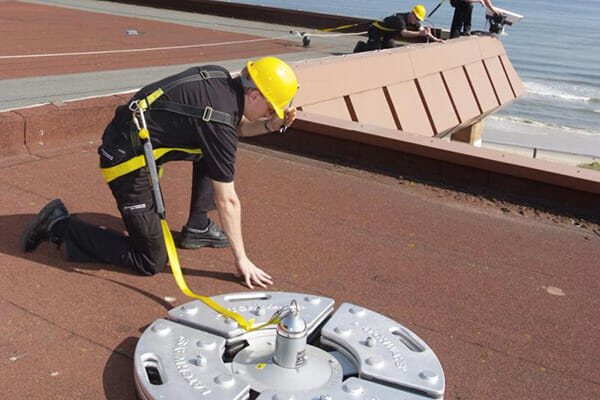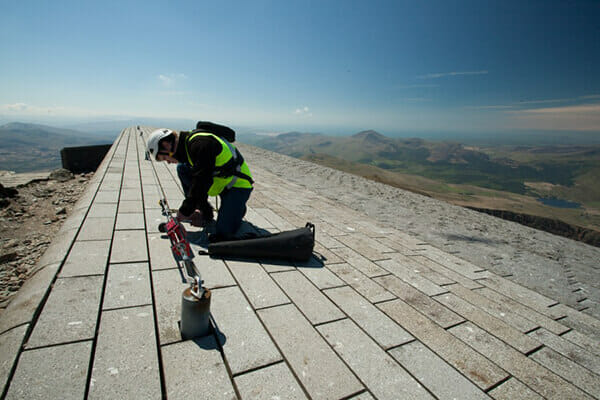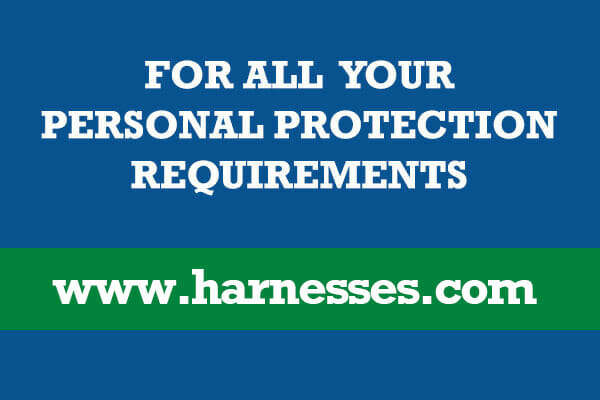Fall Prevention vs Fall Arrest vs Fall Restraint
What is the difference between different types of fall protection helping with fall prevention?
| Fall Prevention | Fall Restraint | Fall Arrest | |
|---|---|---|---|
| How does it protect? | Prevents people from reaching the fall hazard by creating a barrier between the person and the fall hazard | Prevents people from reaching a fall hazard through a tie off system. | Stops a fall that is in progress through a tie off system. |
| Equipment Needed | No individual equipment | Custom fitted equipment | Custom fitted equipment |
| Training Needed | None | Yes, extensive and ongoing | Yes, extensive and ongoing |
| Inspection | After Install and Annually | Every Use by the Individual | Every Use by the Individual |
| Maintenance | Annually | Must be inspected and cared before and after every use. | Must be inspected and cared before and after every use. |
| Potential for Injury | None | Mild | High |
| Costs | Higher up front costs. | Lower initial costs but hidden costs might be: training, equipment maintenance, and setup time. | Lower initial costs but hidden costs might be: training, equipment maintenance, and setup time. |
| Burden to Laborer | Little to none. | Must inspect and properly wear their equipment. | Must inspect and properly wear their equipment. |
| EU Directives Preference | Preferred because there is the least risk. | Better than fall arrest. |
| Fall Prevention | |
|---|---|
| How does it protect? | Prevents people from reaching the fall hazard by creating a barrier between the person and the fall hazard |
| Equipment Needed | No individual equipment |
| Training Needed | None |
| Inspection | After Install and Annually |
| Maintenance | Annually |
| Potential for Injury | None |
| Costs | Higher up front costs. |
| Burden to Laborer | Little to none. |
| EU Directives Preference | Preferred because there is the least risk. |
| Fall Restraint | |
|---|---|
| How does it protect? | Prevents people from reaching a fall hazard through a tie off system. |
| Equipment Needed | Custom fitted equipment |
| Training Needed | Yes, extensive and ongoing |
| Inspection | Every Use by the Individual |
| Maintenance | Must be inspected and cared before and after every use. |
| Potential for Injury | Mild |
| Costs | Lower initial costs but hidden costs might be: training, equipment maintenance, and setup time. |
| Burden to Laborer | Must inspect and properly wear their equipment. |
| EU Directives Preference | Better than fall arrest. |
| Fall Arrest | |
|---|---|
| How does it protect? | Stops a fall that is in progress through a tie off system. |
| Equipment Needed | Custom fitted equipment |
| Training Needed | Yes, extensive and ongoing |
| Inspection | Every Use by the Individual |
| Maintenance | Must be inspected and cared before and after every use. |
| Potential for Injury | High |
| Costs | Lower initial costs but hidden costs might be: training, equipment maintenance, and setup time. |
| Burden to Laborer | Must inspect and properly wear their equipment. |
| EU Directives Preference |
Fall Restraint, Fall Arrest, and the Hierarchy of Fall Prevention
The terms ‘fall restraint’ and ‘fall arrest’ are now considered commonly used terms for Fall Prevention/Fall Protection. However, it is crucial to understand where and why a particular system should be specified. There will be many references and information contained on our site for your use.
Hierarchy of Fall Protection
It is generally accepted by governing bodies that the hierarchy of fall protection should provide the starting point for considering what type of fall protection system is required.
1. Eliminate the risk
Avoid work at height where possible or locate plant and equipment in safe locations where there is no risk of a fall.
2. Guard the hazard
When working at height is essential, to ensure that workers are not exposed to unnecessary risks, consider providing a parapet or guardrail to eliminate the fall hazard.
3. Protect the worker
Where it is not possible to eliminate the risk of falling use a suitable fall protection system to minimise the consequences of a fall. This can be achieved with a fall arrest or fall restraint system however please bear in mind that these are two completely different entities.
In essence, a fall restraint system prevents workers from reaching a hazard whereby a fall arrest system allows workers to reach a hazard and then protects them if they should fall. See our video section where this is illustrated for you.
Fall Restraint
These systems allow a person access to conduct their duties but prevent them from reaching a point where a fall could occur.
Fall Restraint systems are generally suitable if the person needs to work at the edge of a hazard. For example where there is a need to maintain gutters along the edge of a roof or if there are other potential fall hazards such as a fragile roof, roof lights, or air vents.
If fitting a fall restraint system it is recommended that the system should be tested to fall arrest loads to ensure a person’s safety in situations where the system may be misused (i.e. when the person using it wears an over-length lanyard to enable access to the edge of a roof).
Fall prevention systems are generally positioned more than 2.3 m from the hazard. This is because common practice is for the worker to be connected to the system by a fixed-length 1.8 m lanyard.
Fall Arrest
A fall arrest system provides maximum freedom of movement for workers to conduct their duties. In doing so it allows them to reach the point where a fall could occur such as the edge of a roof for gutter maintenance. However, in the event of a fall, the fall will be arrested and so allow the person to either effect a self-rescue or be rescued.
Rescue
Following a fall consideration must be given to the rescue of the worker there is a legal obligation to have a full and comprehensive rescue plan in place when individuals are working at height. There are several methods available for rescue including special harnesses.
For further information on how the personal rescue device is used please watch our demonstration video.
Fall Arrest vs Fall Restraint
The difference between Fall Arrest and Fall Restraint





